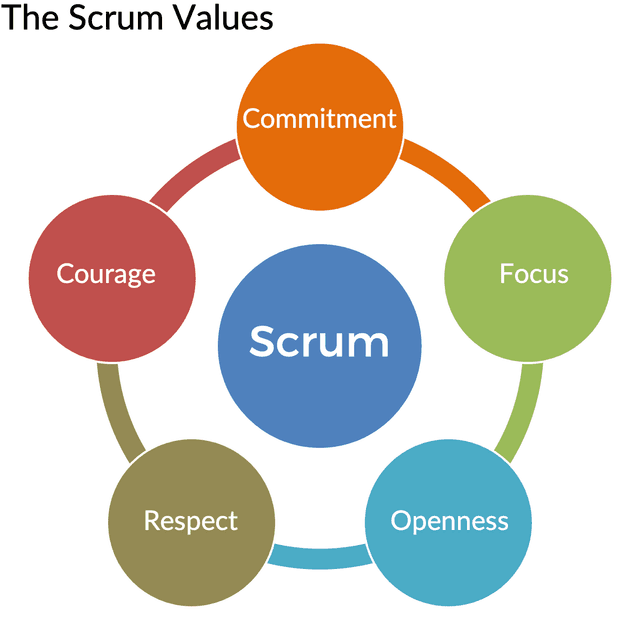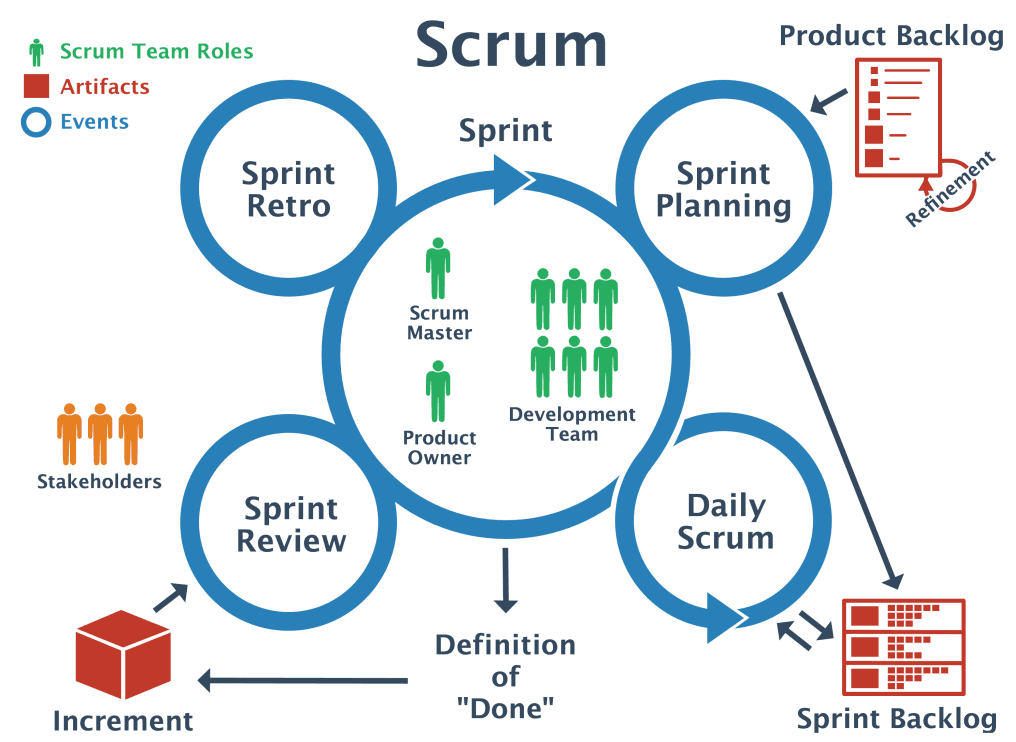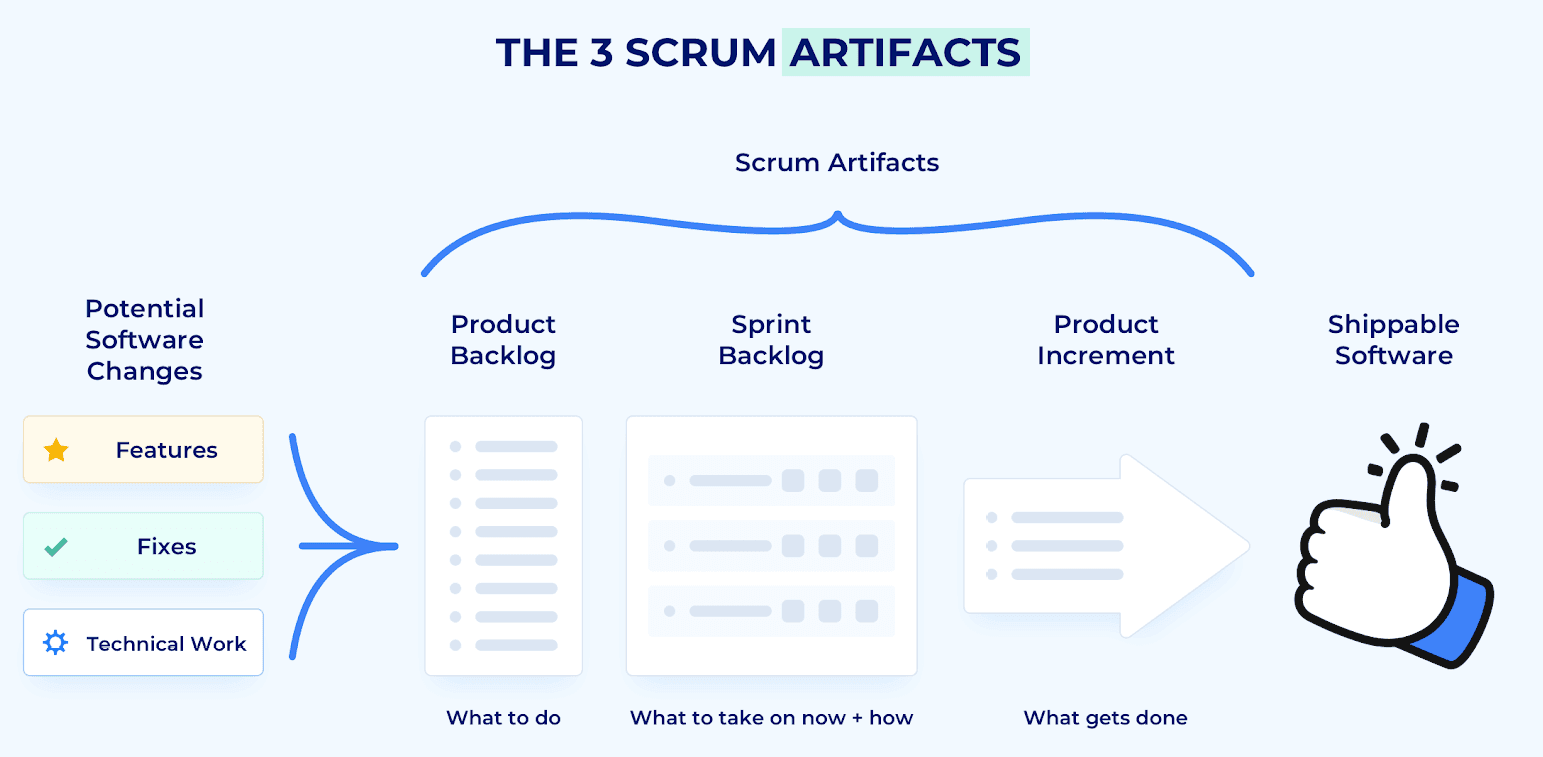Developing a new product and succeeding in the marketplace isn’t an easy task. Right! Good products always captivate the target audience by addressing customer needs and simultaneously improves the business value. And, Scrum methodology helps you achieve that by solving complex business problems.
Scrum is an agile approach that helps to manage projects in software development. Often, Agile software developments with Scrum are viewed as a methodology. In this article, we’ll discuss what Scrum methodology is and the core concepts involved in Scrum development.
What is the Scrum Methodology - Table of Content
- What is Scrum Project Management?
- Who uses the Scrum Methodology?
- Principles of Scrum
- Scrum values
- Scrum Development: what’s involved?
- Scrum Process: The artifacts
- Scrum project: Main Roles
- Benefits of using Scrum methodology
What is Scrum Project Management?
Scrum is an agile framework used majorly for software development projects with the intent to deliver new software capability in the time period of 2-4 weeks. It is one of the approaches that influenced the Agile manifesto, which combines a set of principles and values to develop high-quality software faster.
| If you want to enrich your career and become a professional in Scrum, then visit Mindmajix - a global online training platform: "Scrum Training" This course will help you to achieve excellence in this domain. |
Who uses the Scrum methodology?
Scrum has streamlined software development, and professionals all over the world have realized the value of using Scrum. In fact, of all the available Agile frameworks, Scrum is the most widely adopted framework across software companies. Almost 70 percent of software teams rely on Scrum or Scrum variants.
It has the power to transform project management across every business, industry, and even across life in general. Scrum can benefit any team in working on a common goal. In particular, it’s a collection of tools, roles, and meetings that work together to help teams and manage workload.
Principles of Scrum
Scrum depends on three pillars of empirical process control, such as transparency, inspection, and adaptation.
- Transparency - To make better decisions, everyone in the team needs better visibility into the process and the product's current state. Scrum reviews provide transparency, such that every team member and stakeholder gets a clear view of the project.
- Inspection - To prevent variation in the end product or desired process, a team needs to inspect what work is being completed and how at regular intervals. Scrum reviews and retrospectives offer inspection.
- Adaptation - At the end of every iteration, Scrum allows adjustments. Adaptation is the continuous improvements, the ability to adapt based on the results of the inspection. Scrum teams can adapt the product at the end of each Sprint.
Scrum Values
Scrum is underpinned by three pillars transparency, inspection, and adaptation. The entire work in the scrum framework should be visible to all the team members responsible for the outcome (workflow, process, progress, etc.) and the following five principles of Scrum will enable it:
| Related Article: Scrum Tutorial |

Commitment: Every team member individually commits to achieving team goals.
Courage: Everyone in the team how to work on conflicts and challenges together to do the right things.
Focus: Team members focus entirely on the goals of the team and the sprint backlog.
Openness: Stakeholders and team members are open to any work and challenge the team encounters.
Respect: Each member of the team technically respects each other to be capable and independent.
Scrum Development: What’s involved?
The scrum model suggests the product progress via a series of sprints. In agile methodology, sprints are a time-boxed period (2-4 weeks) during which a particular work is completed and made ready for review.
Scrum methodology recommends sprint planning at the start of the Sprint. The product owner and the entire team decide what work to be performed in the Sprint and create a sprint backlog (tasks to be executed during the Sprint).
| Related Article: Agile Project Management With Scrum |
During the scrum sprint, the team implements a set of features and tests the functionality. In the end, after these features are done (coded and tested), they are integrated into a system or evolving product.

On each day of the Sprint, there will be super-short meetings (not more than 15 minutes) in which every team member transparently covers the progress covered since the last stand-up and plans the work to be completed before the next meeting. The goal of stand-up is to raise your concerns about meeting the sprint goal.
Some of the questions that might be asked of every team member in the context of achieving the sprint goal are:
- What did I do yesterday to reach the Sprint Goal that helped the Development Team?
- What will I do today to meet the Sprint Goal that supports the development team?
- Do I see any impediment that limits the Development Team or me from reaching the Sprint Goal?
The scrum model views daily scrum meetings as a way to improve the team member's work as everyone their work status of the Sprint.
Sprint review takes place at the end of the Sprint, where the entire team gets together to review the results of the Sprint with the stakeholder of the product. The goal of this meeting is to discuss, demonstrate, and potentially give a chance to stakeholders, to increment in order to get feedback.
| Related Article: Scrum Master Roles and Responsibilities |
The product owner confirms the work against the predefined acceptance criteria, and the stakeholders provide feedback with ensuring the delivered increment met the business need.
The final activity in scrum development is retrospective, where the whole team participates in this meeting to discuss how things went in the previous Sprint and identify adjustments they could make as we advance.
The goal of this retrospective is to allow the scrum team to inspect itself and build a plan for adjustments to be performed in the next Sprint.
Scrum Process: The Artifacts
At the end of each sprint, the Scrum model expects the team to bring the product/system to a potentially shippable state. Artifacts are something either like a tool that solves problems or a work of art that inspires us. In Scrum, there are three essential Artifacts, such as sprint backlog, product backlog, and increment.

Product backlog: It is the most important document that outlines each and every requirement of a product, system, or project. This includes a list of features, fixes, and enhancements to be made as to the input for the sprint backlog. They are continuously revisited and reprioritized by the product owner.
| Related Article: Scrum Workflow |
Sprint backlog: It includes a list of items, bug fixes, or user stories decided by the development team to implement in the current sprint cycle. In sprint planning, before each Sprint, the team chooses some tasks necessary to deliver those product backlog items and achieve the Sprint Goal. In scrum project management, the product backlog can be viewed as a list of features to be made (written in the form of user stories), whereas, the sprint backlog is a to-do list for the Sprint.
Increment: The usable end product from Sprint is called increment. It's a sum of product backlog items that meet the team's requirements by the end of the Sprint. The product owner will decide on the increment release or build upon it in future sprints.
Additional artifacts that result in Scrum methodology are the Sprint burndown chart and release burndown chart. The Burndown chart displays the remaining work in the sprint backlog and gives a simple view of the sprint progress.
| Related Article: Checkout Scrum Interview Questions |
Scrum project: Main Roles
There are three roles in the Scrum team: Scrum master, product owner, and development team. As scrum teams are cross-functional, the development team includes designers, testers, etc., in addition to the developers.
- Scrum master
- Product owner
- Development team
Scrum Product Owner - The product owner determines how the product will look and the features it should contain. They incorporate the stakeholder’s feedback to get the highest value product increments in each Sprint. Effective product owners:
- Define and announce releases
- Build and manage product backlog
- Give clear guidance on which features to deliver next.
- Communicate delivery and team status
- Ensure the product backlog is transparent and visible
Scrum Master - Scrum Master helps the team to perform at their best level. They guide teams, product owners, and scrum process businesses in fine-tuning their practices. An effective Scrum master profoundly understands how the work is being done by the team and helps to optimize their transparency and delivery flow.
Development team - The development team includes 3 to 9 members excluding the scrum master and product owner, who carry out all the tasks to build increments of valuable output every Sprint. They are supporters of sustainable development practices.
| Related Article: Agile vs Scrum |
Benefits of using Scrum methodology:
Organizations that have adopted the Scrum methodology have experienced:
- Higher productivity
- Quicker release of the useable product to customers
- Better-quality products
- More alignment between business and IT
- Better visibility into projects
- Increased ability to manage to change priorities
- Lower costs
- Better team dynamics
- Better user satisfaction
- Easily scalable
- Reduction of risks
- Improved stakeholder satisfaction
Conclusion
With this, we have come to the end of this “what is Scrum methodology?” article. We tried to cover all the concepts you need to be aware of using Scrum methodology. Hope the information shared is clear.
If you have any questions? Let us know by commenting below and our subject matter experts will get back to you.
 On-Job Support Service
On-Job Support Service
Online Work Support for your on-job roles.

Our work-support plans provide precise options as per your project tasks. Whether you are a newbie or an experienced professional seeking assistance in completing project tasks, we are here with the following plans to meet your custom needs:
- Pay Per Hour
- Pay Per Week
- Monthly
| Name | Dates | |
|---|---|---|
| Scrum Training | Jan 10 to Jan 25 | View Details |
| Scrum Training | Jan 13 to Jan 28 | View Details |
| Scrum Training | Jan 17 to Feb 01 | View Details |
| Scrum Training | Jan 20 to Feb 04 | View Details |

Madhuri is a Senior Content Creator at MindMajix. She has written about a range of different topics on various technologies, which include, Splunk, Tensorflow, Selenium, and CEH. She spends most of her time researching on technology, and startups. Connect with her via LinkedIn and Twitter .














